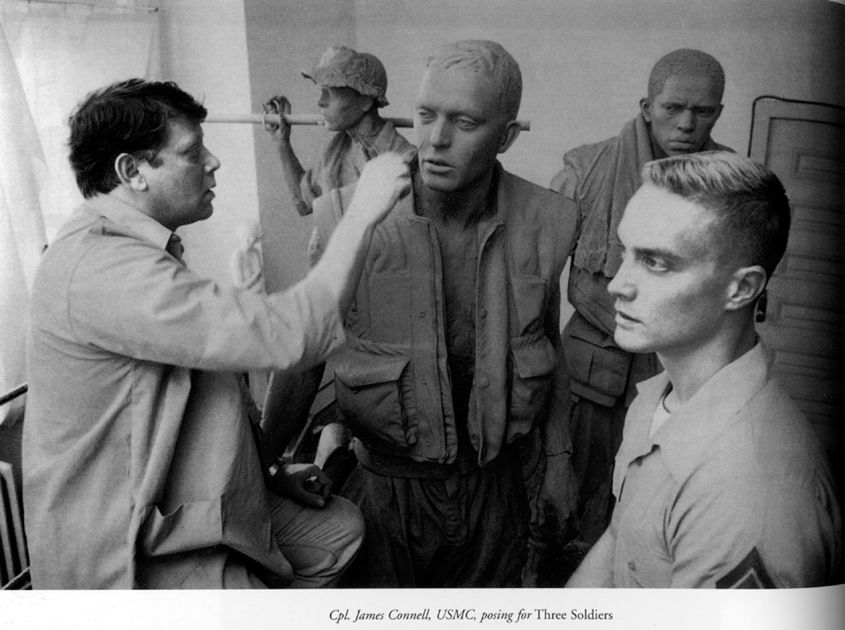
The Wall vs. "Three Soldiers"
|
“If you wish to save the last of your dignity, do not call
your best actions a ‘sacrifice’: that term brands you as immoral… If a man dies
fighting for his own freedom, it is not a sacrifice….” Ayn Rand, “Atlas Shrugged”, p. 1029 (HC) |
|
|

"The black gash of shame and sorrow."
|
This wall is a memorial to sacrifice. The "purpose" of that wall, wrote the New Republic, is "to impress upon the visitor the sheer human waste, the utter meaninglessness of it all...To treat the Vietnam dead like some monstrous traffic accident is more than a disservice to history; it is a disservice to the memory of the 57,000 [killed in Vietnam]." "....a V-shaped wall, period, a wall of polished black granite inscribed only with the names; no mention of honor, courage or gratitude; not even a flag. Absolutely skillproof, it was. Many veterans were furious. They regarded [Maya Ying Lin's] wall as a gigantic pitiless tombstone that said, ''Your so-called service was an absolutely pointless disaster.'' They made so much noise that a compromise was struck. An American flag and statue would be added to the site. Hart was chosen to do the statue. Naturally enough, Lin was miffed at the intrusion, and so a make-peace get-together was arranged in Plainview, N.Y., where the foundry had just completed casting the soldiers. Doing her best to play the part, Lin asked Hart -- as Hart recounted it -- if the young men used as models for the three soldiers had complained of any pain when the plaster casts were removed from their faces and arms. Hart couldn't imagine what she was talking about. Then it dawned on him. She assumed that he had followed the lead of the ingenious art worldling George Segal, who had contrived a way of sculpturing the human figure without any skill whatsoever: by covering the model's body in wet plaster and removing it when it began to harden. No artist of her generation (she was 21) could even conceive of a sculptor starting out solely with a picture in his head, a stylus, a brick of moist clay and some armature wire. No artist of her generation dared even speculate about . . . skill."
The Lives They Lived: Frederick Hart, b. 1943;
The Artist the Art World Couldn't See |

Heroes Against The Wall
|
Vietnam Veteran James Webb Jr., a Marine Platoon leader awarded the Navy Cross, resigned from the National Sponsoring Committee of the Vietnam Veterans Memorial Fund, to protest the memorial design. He said “I never in my wildest dreams imagined such a nihilistic slab of stone.” Tom Carhart, a veteran and outspoken opponent of the minimilistic design referred to it as "the black gash of shame and sorrow". it commemorates the war "as some ugly, dirty experience of which we were all ashamed." Cahart, a West Point graduate who led an infantry platoon of the 101st Airborne Division in Vietnam, and received two Purple Hearts was in 1981 a civilian lawyer at the Pentagon. Adm. James Stockdale, a prisoner of war awarded the Medal of Honor, also resigned. |
|
The Marine Corps League withdrew its support for the memorial as insulting and denigrating those who came home from Vietnam and those who did not. |
|
"Three Soldiers" by Frederick Hart |
|
" A trio of tired soldiers...of
warriors larger than life."
"Mr. Hart is a sculptor
in the 'neo-traditional' mode, which means you can tell what the sculpture
is about merely by looking at it. The three soldiers look like three
soldiers, tired and heroic."
"Hart captured in stone
something vivid, urgent, and alive." |
|
"...there is about them the physical contact and sense of unity that speaks of bonds of love....And yet each one is alone. Their true heroism lies in these bonds of loyalty, in their aloneness, and in their vulnerability." (Frederick Hart) |
Compiled by Robert Tracy. June 1, 2011.